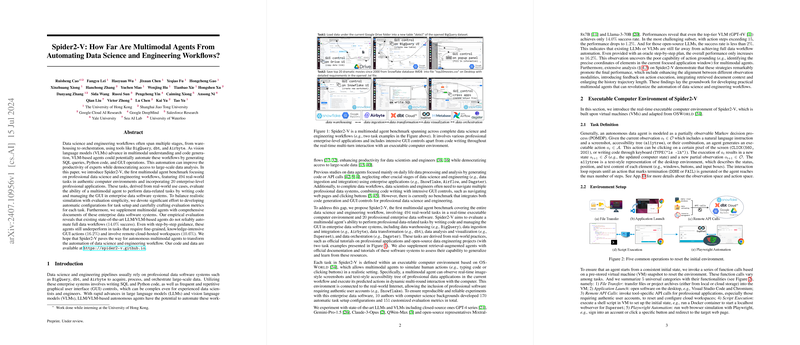An Expert Overview of Spider2-V: Multimodal Agents in Data Science and Engineering Workflows Automation
The paper, "Spider2-V: How Far Are Multimodal Agents From Automating Data Science and Engineering Workflows?" introduces a benchmark designed to evaluate the efficacy of multimodal agents in automating complex data workflows. Spanning multiple stages from data warehousing to orchestration, the benchmark integrates both graphical user interface (GUI) controls and coding tasks, thereby reflecting the real-world complexities encountered in professional data science and engineering environments. Below, we provide an expert analysis of the paper, focusing on its methodology, empirical findings, and the broader implications for advancing AI.
Benchmark Design and Objectives
Spider2-V is conceived to address the inadequacies of existing benchmarks, which predominantly focus on either code generation or daily life data manipulation tasks. The Spider2-V benchmark encompasses:
- 494 Real-World Tasks: Derived from enterprise-level applications, spanning warehousing (e.g., BigQuery), data transformation (e.g., dbt), ingestion (e.g., Airbyte), visualization (e.g., Superset), orchestration (e.g., Dagster), traditional data processing, and IT service management (e.g., ServiceNow).
- GUI and CLI Integration: Unlike its predecessors, Spider2-V evaluates agents on tasks requiring both code generation and GUI operations to simulate authentic working conditions encountered by data professionals.
- Evaluation Metrics and Automatic Configurations: Carefully crafted evaluation scripts and automatic task setup configurations ensure objective and reproducible assessments.
Empirical Evaluation and Findings
The empirical evaluation of leading LLMs and vision LLMs (VLMs), including state-of-the-art incumbents like GPT-4V, reveals their current limitations:
- Low Success Rates: The most advanced VLM, GPT-4V, achieves only a 14.0% success rate, underscoring significant challenges in automating fully-fledged data workflows.
- GUI Operation Challenges: Tasks requiring intensive GUI interactions show particularly poor success rates due to inadequate fine-grained control and action grounding capability.
- Variability in Task Categories: Success rates vary notably across different task categories, with CLI-only tasks being notably challenging due to the complex and precise nature of code generation involved.
Factors Affecting Performance
Detailed analysis identifies several key factors influencing agent performance:
- Task Complexity: Tasks with a higher number of inherent action steps see markedly lower success rates, spotlighting the difficulty in sequentially complex operations.
- Real-World Account Usage: Tasks requiring authentic user accounts for cloud-hosted services (e.g., BigQuery, Snowflake) pose additional hurdles due to network delays and unexpected user interface changes.
- Observation Types: Performance improves notably when agents utilize a combination of screenshots and accessibility trees, and further when these modalities are effectively aligned using a Set-of-Mark (SoM) approach.
Future Research Directions and Implications
The findings from Spider2-V highlight several areas for future research and development:
- Enhanced Modal Alignment: Improving the alignment between different observation modalities (e.g., text, image) could significantly boost the agent's ability to perform GUI operations accurately.
- Incorporating Feedback Mechanisms: Integrating better feedback and error correction mechanisms would mitigate the issues arising from incorrect action execution.
- Retrieval-Augmented Generation: Leveraging extensive documentation and retrieval techniques to bridge the knowledge gap in domain-specific enterprise applications remains a promising avenue.
Conclusion
Spider2-V provides a rigorous and comprehensive platform for benchmarking multimodal agents, exposing the substantial gap between current capabilities and the ideal of fully autonomous data science workflows. The meticulous task design and real-world relevance make Spider2-V a valuable resource for the AI research community, fostering advancements in the integration of LLMs, vision models, and interactive agents capable of navigating and automating professional data environments.
As AI models and techniques continue to evolve, Spider2-V serves as both a benchmark for current progress and a beacon for future innovation in the automation of data science and engineering workflows. The benchmark underscores that while current models possess notable limitations, the path to significantly more capable multimodal agents lies in addressing these challenging, real-world scenarios.
